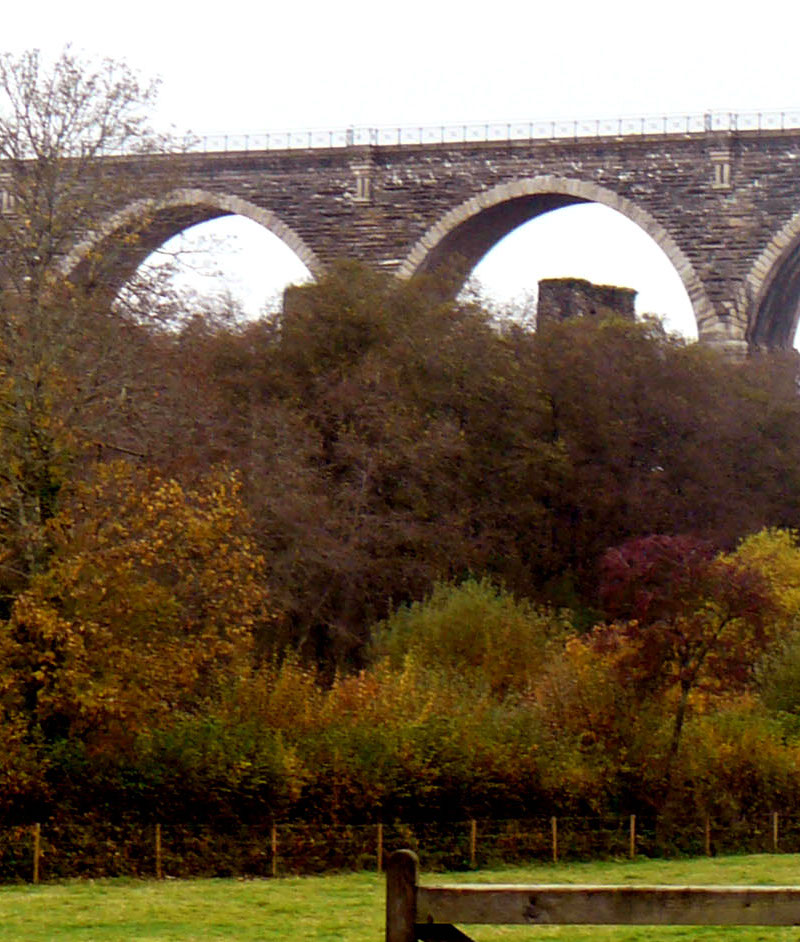
Liskeard (formerly called Moorswater) Viaduct, Cornwall, which replaced Isambard Kingdom Brunel's original 1859 railway viaduct in 1881. The engineer for this later structure was P. J. Margary. The viaduct and adjacent earlier piers are Grade II* listed. The listing text explains that the Resident engineer, H. G. Cole, was killed during the rebuilding when a crane overturned, and was succeeded by T. H. Gibbons. These large engineering projects were not without human as well as financial costs.

Closer view of piers, with the long disused Brunel piers glimpsed through the arch on the right.
According to the listing text, the viaduct is 290 metres long and 49 metres high, but the Railway Engineer of 1899 gives its height as 148' (see Gibbons 321), which is a fraction over 45 metres, and there is general agreement on this lower figure in other sources. The listing text gives a more accurate description of the design and materials: "Seven tapering piers of snecked rock-faced slatestone with eight semi-circular arches with granite long and short voussoirs. Moulded corbel course with moulded stone brackets supporting an iron parapet railing of uprights, lattice braces and ornamental adjustment rings. Contemporary refuges corbelled out on paired stone brackets." It describes the remains of Brunel's work in the earlier piers on the south side as being "similar to those used in St Pinnock viaduct [the tallest viaduct in Cornwall]..... Roughly-dressed, coursed slatestone with stepped buttresses" and so forth. Of the features mentioned here, only the "new" viaduct's iron parapet railing, lattice braces and ornamental adjustment rings can be seen clearly.

Diagram of the viaduct in The Railway Engineer (Gibbons 322).
More information can be found in The Railway Engineer of October 1899:
Following the amalgamation of the Cornwall with the Great Western R. Co., the narrowing of gauge works ensued in 1892, and soon afterwards the work of viaduct reconstruction in Cornwall, in connection with the doubling of certain sections of the line, was undertaken on a large scale, The general lines of the earlier reconstruction were not changed — that is to say, where the height of the old viaducts and the piers admitted it, new steel superstructures were erected on the original piers, which were raised for the purpose. [Gibbons 323]
In this case, however, the original piers could not be used; but their remains are not only still to be seen, but valued for their historical interest. Incidentally, T. H. Gibbons's account includes details of how the building work proceeded, using "four Scotch derrick-cranes worked by steam, which stood on stages of 70 feet in height so that they could handle material for the masons at a height of 120 feet above the level of the ground" (321). It was an accident with one of these that killed the original Resident engineer, as noted in the March 1881 issue of The Railway Engineer: "By this lamentable accident Mr Cole was curt off from a professional career of more than ordinary promise at the age of 26 years" (95).
Photographs by Colin Price, and scanned image and text by Jacqueline Banerjee, with thanks to Colin for his research. You may use these images without prior permission for any scholarly or educational purpose as long as you (1) credit the photographer and (2) link your document to this URL in a web document or cite the Victorian Web in a print one.
Bibliography
"The Moorswater Viaduct." The Railway Engineer 2 (1881): 94-95. (Free Ebook in Google Books).
Gibbons, T. H. "Railway Viaducts in Cornwall, Old and New." The Railway Engineer 20 (1899): 320-29. (Free Ebook in Google Books).
"Viaduct Including Adjacent Piers to Earlier Viaduct, Liskeard." British Listed Buildings. Web. 6 March 2021.
Created 7 March 2016